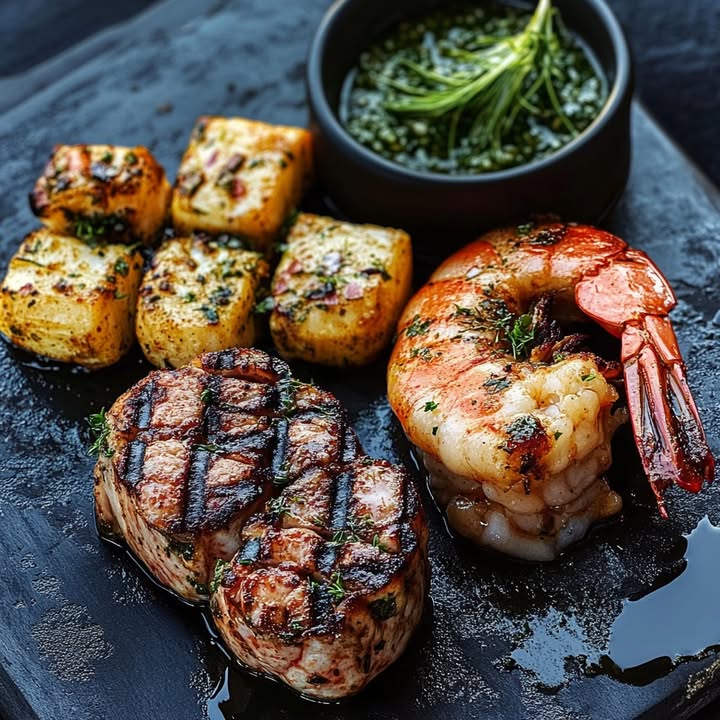Why This Spanish Fish Stew Will Steal Your Heart
There’s something magical about a bowl of hearty stew. It’s like a warm hug for your soul, isn’t it? Last winter, I stumbled upon this Spanish Fish Stew recipe while craving comfort food with a Mediterranean twist. One bite in, and I was transported to sun-soaked shores with every mouthful. What makes this dish stand out is how simple yet flavorful it is. The combination of tender fish, creamy potatoes, and zesty spices creates layers of texture and taste that feel like a celebration in your mouth.
A Little History Behind the Dish
This stew draws its roots from Spain’s rich coastal cuisine. Traditionally, fishermen would toss whatever seafood they had left into a pot with tomatoes, potatoes, and spices to create a nourishing meal after a long day at sea. Over time, this humble dish evolved into a beloved classic served across Spanish households. I first tried making this stew during a family dinner challenge—each of us had to cook something inspired by another culture. Spoiler alert: mine won hands down!
Why You’ll Fall in Love With This Recipe
First off, let me tell you—it’s easy. No fancy techniques or hours spent slaving over the stove. Just good ingredients coming together beautifully. The smoky paprika pairs perfectly with the fresh lemon juice, while the tender chunks of fish and shrimp add elegance without being fussy. Plus, it’s packed with nutrients thanks to the veggies and protein-rich seafood. Whether you’re cooking for yourself or hosting friends, this Spanish Fish Stew will impress everyone.
When to Whip Up This Delight
This dish is perfect for cozy nights when you want something comforting but still light enough not to weigh you down. Serve it on chilly evenings with crusty bread for dipping, or bring it out as the star of a casual dinner party. It also works wonders for Sunday lunches or even holiday gatherings where you need a crowd-pleaser.
What You’ll Need
- 2 tablespoons olive oil
- 1 medium onion, finely chopped
- 4 garlic cloves, minced
- 1 fennel bulb, thinly sliced
- 3 medium potatoes, cut into 1.5 cm cubes
- 2 teaspoons smoked paprika
- 1 teaspoon sweet paprika
- ½ teaspoon red chili flakes
- Juice of one lemon
- 1 can (400g) crushed tomatoes
- 250 ml fish stock
- 125g canned chickpeas, drained and rinsed
- 250g shrimp, fresh or frozen
- 400g white fish fillets, skinless and boneless
- Salt and pepper, to taste
- Fresh parsley, chopped, for garnish
Substitutions for Flexibility
No fennel? Swap it with celery for a similar crunch. If you’re not a fan of shrimp, try scallops or mussels instead. For vegetarians, replace the seafood with extra chickpeas and throw in some spinach or kale for color and nutrition. Use vegetable broth if needed, and adjust the spices to suit your palate.
Let’s Get Cooking!
Step 1: Sauté Those Aromatics
Start by heating the olive oil in a large pan with a lid. Add the onions and sauté them until they turn soft and translucent. Next, toss in the garlic and fennel. Cook for another minute or two until everything smells absolutely divine. Pro tip: Don’t rush this step; letting the aromatics soften slowly builds depth of flavor.
Step 2: Toss In the Potatoes
Now comes the fun part—add those cubed potatoes. Cover the pan and let them cook for about five minutes. Stir in the smoked paprika, sweet paprika, and chili flakes. Watch as the spices coat the potatoes, turning them a gorgeous reddish hue. This step fills your kitchen with an irresistible aroma that’ll make everyone come running.
Step 3: Pour in the Liquids
Squeeze in the lemon juice, then pour in the crushed tomatoes and fish stock. Bring the mixture to a simmer, cover, and let it bubble away for 15 minutes. By now, the potatoes should be almost fork-tender, and the sauce will have thickened slightly. Chef’s tip: Taste the broth here and tweak the seasoning if needed—it sets the tone for the entire dish.
Step 4: Add the Seafood
Time to introduce the stars of the show! Gently stir in the chickpeas and shrimp, then lay the fish fillets on top. Lower the heat, cover again, and cook for 8–10 minutes. The fish will flake easily with a fork when done. Resist the urge to stir too much; you want those beautiful pieces of fish to stay intact.
Step 5: Garnish and Serve
Finish with a sprinkle of fresh parsley for brightness. Serve piping hot alongside crusty bread drizzled with olive oil. It’s rustic, satisfying, and utterly delicious. Trust me, your guests will rave about it!
Timing Is Everything
Preparation takes just 10 minutes, while cooking clocks in at around 40 minutes. Altogether, you’re looking at 50 minutes from start to finish. Perfect for busy weeknights or lazy weekends alike.
Chef’s Secret
For an extra layer of flavor, toast the spices briefly in the pan before adding liquids. It enhances their aroma and gives the stew a deeper profile. Try it—you won’t regret it!
An Interesting Fact
Did you know that smoked paprika is a staple in Spanish cuisine? Known locally as “pimentón,” it’s made by drying peppers over oak wood fires, giving it that distinctive smoky kick. No wonder it elevates dishes like this Spanish Fish Stew.
Necessary Equipment
You’ll need a large skillet or Dutch oven with a lid, a sharp knife for chopping, measuring spoons, and a wooden spoon for stirring. Simple tools for a simply amazing dish.
How to Store Leftovers
Once cooled, transfer any leftovers to an airtight container and refrigerate within two hours. This stew keeps well for up to three days in the fridge. Reheat gently on the stovetop, adding a splash of water or broth to loosen the sauce if needed.
If you’ve made a big batch, freezing is a great option. Portion it into freezer-safe containers and label them with the date. It can last up to three months frozen. Thaw overnight in the fridge before reheating.
Remember, the flavors intensify over time, so don’t hesitate to enjoy it the next day—it might taste even better!
Tips and Advice
To elevate your stew, use homemade fish stock for unparalleled richness. Keep an eye on the fish while cooking—it can go from perfectly tender to overcooked quickly. Lastly, always season in layers. Add salt and pepper at different stages rather than all at once for balanced results.
Presentation Ideas
Serve in shallow bowls with a sprig of parsley perched elegantly on top. Drizzle a bit more olive oil for shine. Pair with slices of grilled baguette rubbed lightly with garlic for added flair. Or, go rustic and serve family-style right from the pot.
Healthier Alternatives
- Low-Carb Version: Replace potatoes with cauliflower florets.
- Dairy-Free Option: Skip butter-based toppings and stick to olive oil.
- Gluten-Free Twist: Ensure your stock is gluten-free and serve with gluten-free bread.
- Vegan Adaptation: Omit seafood entirely and bulk up with mushrooms and lentils.
- Protein-Packed: Add more chickpeas or introduce quinoa for a boost.
- Spice Lover’s Dream: Increase the chili flakes or add diced jalapeños for heat.
Common Mistakes to Avoid
Mistake 1: Overcooking the Fish
Fish cooks fast, and leaving it bubbling for too long turns it rubbery. To avoid this, add it towards the end of cooking. Once it flakes easily, it’s ready to serve.
Mistake 2: Skipping the Spice Toasting
Raw spices can taste flat. Taking a moment to toast them releases oils that enhance their flavor significantly. It’s worth the extra effort!
Mistake 3: Using Old Spices
Spices lose potency over time. Check yours for freshness, especially the paprika, which plays a starring role in this stew.
Mistake 4: Adding Too Much Salt Early
Seafood naturally contains sodium, so wait until the final stages to season. Adjust gradually to prevent oversalting.
FAQs About Spanish Fish Stew
Can I Make This Ahead?
Absolutely! Prepare everything except the fish and shrimp, then refrigerate. When ready to eat, reheat the base and add the seafood at the last minute.
Is This Recipe Kid-Friendly?
Yes! Kids love the mild flavors and creamy textures. Just dial back the chili flakes if they’re sensitive to spice.
What Type of Fish Works Best?
Choose firm, white-fleshed varieties like cod, haddock, or halibut. They hold up well during cooking.
Can I Use Fresh Tomatoes Instead of Canned?
Of course! Dice ripe tomatoes and simmer them longer to achieve a thicker consistency.
How Do I Know When the Potatoes Are Done?
They should pierce easily with a fork but still retain their shape. Undercooked potatoes ruin the experience.
Does It Work Without Wine?
Definitely. The lemon juice adds acidity, eliminating the need for wine unless you prefer it.
Can I Freeze This Dish?
Yes, though it’s best to freeze without the seafood. Add fresh seafood upon thawing and reheating.
Why Does My Stew Taste Bland?
Check your spices and ensure you’re using quality ingredients. Also, remember to season in layers throughout the process.
Should I Peel the Potatoes?
It’s optional. Leaving the peel on adds fiber and rustic charm, but peeling gives a smoother texture.
What Bread Goes Well With This?
Crusty baguettes or ciabatta are ideal for soaking up the flavorful broth. Grilled slices rubbed with garlic are heavenly.
So there you have it—a complete guide to mastering Spanish Fish Stew. Whether you’re a seasoned home cook or a beginner eager to try new recipes, this dish promises satisfaction in every bite. Gather your ingredients, put on some music, and let the magic happen. Bon appétit!

Spanish Fish Stew
Ingredients
Equipment
Method
- Heat the olive oil in a large pan with a lid. Sauté the onions until soft and translucent.
- Add the garlic and fennel, cooking for another minute.
- Add the cubed potatoes and cover, cooking for about five minutes.
- Stir in the smoked paprika, sweet paprika, and chili flakes.
- Squeeze in the lemon juice, pour in the crushed tomatoes and fish stock, bring to a simmer, and cover for 15 minutes.
- Stir in the chickpeas and shrimp, lay the fish fillets on top, cover, and cook for 8–10 minutes.
- Sprinkle with fresh parsley and serve hot with crusty bread.
